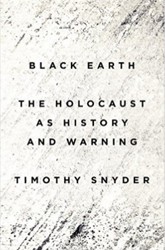By
– August 31, 2011
“Bloodlands” refers to the area which extends from central Poland to western Russia, through Ukraine, Belarus, and the Baltic States where fourteen million noncombatants were murdered between 1933 and 1945. Snyder, a professor of history at Yale, records that the victims were chiefly Jews, Belarusians, Ukrainians, Poles, Russians, and Balts, caught between two genocidal dictators, Hitler and Stalin.
Without diminishing Hitler’s attempt to eliminate the Jews of Europe, Snyder states that the Nazi dictator not only wanted to eradicate the Jews, but also planned to destroy both Poland and the Soviet Union as states. Snyder estimates that if the German war against the USSR had gone as planned, thirty million civilians would have been starved to death during the first winter of the Nazi attack against the Soviet Union that commenced in June 1941, and tens of millions more expelled, killed, assimilated, or enslaved. He goes on to note that the Germans killed as many non-Jews as Jews during the war, chiefly by starving Soviet prisoners of war (more than three million), the shooting of civilians in reprisals, and other methods of killing that resulted in the murder of the better part of a million Belarusians and Poles.
Snyder points out that Stalin, in the name of building “socialism in one country” through a brutal plan of industrialization, was as much a mass murderer as Hitler. He notes that between 1933 and 1939, Hitler was responsible for the murder of 10,000 of his own citizens, whereas during the same period, which witnessed the brutal calculated famine in Ukraine, Stalin oversaw the starvation of millions of his own citizens. From 1939 to 1945, however, Hitler was responsible for the death of millions more than his Soviet counterpart. Snyder concludes that of the fourteen million killed in the “bloodlands” between 1933 and 1945, a third were due to Stalin’s genocidal policies.
Because the Soviets were our Allies after June 1941, we tended to overlook Stalin’s murderous policies toward his own people, which included both Soviet Jewish citizens as well as Jews who fled from different parts of Eastern Europe and the Baltic states to escape the Nazis. Snyder’s book forces us to frame the Holocaust within a wider landscape of genocidal policies by both the Nazis and the Soviets without diminishing the uniqueness of Hitler’s war against the Jews.
Jack Fischel is professor emeritus of history at Millersville University, Millersville, PA and author of The Holocaust (Greenwood Press) and Historical Dictionary of the Holocaust (Rowman and Littlefield).





